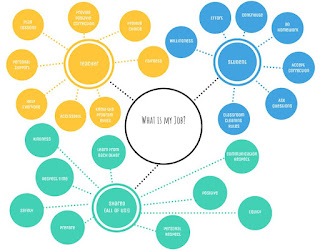Questioning Strategies are Life Skills – Unit 7 Reflections
Sometimes,
when you have children, you get home from work (or they get home from
school) and they say to you “He/she said __________ to me today,
and it hurt my feelings.” And, of course you jump in and coddle
your child and tell them that everyone in the world is mean and big
and scary and of course they are right and good and perfect, and not
to worry about what others say. Right? Probably not. At least that
is not generally been my response. I learned early on to ask
questions. “What happened before you were told this?” “What
did you say or do in return?” “Is there any other reason why
this might have happened?” “What will you do now?” “Is there
something I can or should do?” I am not an unfeeling person,
particularly to my children – actually I have deep feelings, but I
also know that none of us is perfect and we have to use “questioning
strategies” to discover what we really need to know. Sometimes, it
really is that someone was unkind and my child is legitimately hurt.
Sometimes, there were precipitating factors and you need to take
those into consideration when you coach around behaviours and
expectations. Sometimes, in your wisdom, you know where “the line
is” and when you should get involved, but learning not to react
immediately and to use questioning strategies has been very
useful for me.
Being in
a learning environment is no different. As an instructor you need to
learn to use questioning strategies, and as a learner you need to
employ them to learn more deeply.
Both
chapters from this weeks' reading were great. As I have tried to
slow down my reading of the chapters in the text, I find that the
content is useful and categorized nicely. Someone along the way
asked questions about what I needed to know to be an effective
language teacher and how best to organize the content so it would be
effective. That is using questioning strategies.
One of
the content pieces that resonated with me this week is the portion
titled “Categories of Teacher Qutesions (Adapted from Kinsella,
1991)” (Brown & Lee, pp. 264-265), so I want to briefly explore
the value of asking questions in an interactive classroom; which is
what I would hope to have, should I teach a class.
The
categories of questions are: Knowledge, Comprehension, Application,
Inference, Analysis, Synthesis, and Evaluation. When I read those
words I see correlations to Blooms Taxonomy of action verbs that I
regularly refer to when I work on creating objectives for a workshop
or teaching how to develop effective objectives for presentations. I
am not sure if that is a coincidence, but it seems to me that there
is meaning there. We are trying to gear our leaners toward action.
Learning works best when the learners are actively involved. Blooms
Taxonomy verbs are not passive verbs, nor are the question categories
passive. There is something happening here and I am working on
connecting the meaning – I believe these are related. The key for
me would be to know how to build these questioning categories into my
own learning and teaching. Sometimes, for me, the best way to do
that is to leave myself clues and try to teach and learn at the same
time. So, how do I reinforce my own learning into others' learning?
I share it with them so we can use it to reinforce concepts together.
Depending on the class level, I think you can teach that which you
need reminding. Post a list of questions learners could ask to
develop skill around critical thinking using the questioning
categories. Depending on the learner level, your list changes, but
you can use the categories to build your list. It can be used as a
reminder for yourself and a teaching tool for the class.
Reinforcement is the key to success in any learning. You must
practice. Build the practice into your teaching, one question at a
time. Here is an example from my learning this week; perhaps not a
perfect example, but I am still learning.
At the
end of this week, am I able to:
- List the categories of teacher questions? (knowledge)
- State in my own words what each category might be used for? (comprehension)
- Demonstrate how I might use this in a classroom, (or life for that matter)? (application)
- Explain what is meant by the definitions beyond just the words? (inference)
- Outline the value of having a strategy around questioning? (analysis)
- Hypothesize how I might use this in a classroom? (synthesis)
- Verify the value of what I have learned? (evaluation)
Did I
get it? Did I use the questioning categories correctly in my own
learning? I know I did not answer all of them at this time, but I
think I know how to apply them. At least for today. And that is
because I used questioning categories and strategies to help me
learn.
Brown, D. & Lee, H. (2015) Teaching by Principles: An Interactive Approach to Language Pedagogy. Upper Saddle River: Pearson
For one
reference to Blooms Taxonomy of Action Verbs

Comments
Post a Comment